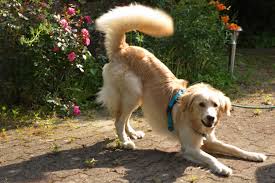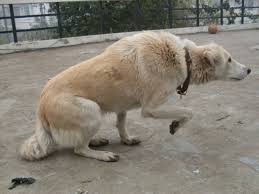The original reason dogs have tails was to provide balance. The tail acts as a counterbalance when the dog is making sharp turns, walking along a narrow structure, running downhill or when jumping and climbing. It also aids in balance and steering when swimming. It almost becomes a type of rudder in the water.
The tail of a dog has also become an important part of communication. When a puppy is born they don’t wag their tail until about six weeks old. They begin to use the tail to communicate with their littermates and their mothers. They also begin to communicate with humans and other animals by wagging their tail.
wag their tail until about six weeks old. They begin to use the tail to communicate with their littermates and their mothers. They also begin to communicate with humans and other animals by wagging their tail.
Another use of the tail in communication is for the benefit of other dogs. They wag their tail to spread the natural scent from their anal gland. Every dog has a scent that is unique to them. These scents are called pheromones. A confident dominant dog often carries their tail high to release more of the scent. A dog that is frightened will hold their tail between their legs. This is so as not to release their scent. Keeping a low profile so to speak.
How does a dog’s tail aid in balance
When a dog is running and has to turn quickly they throw their front end in the direction they want to go. The dogs forward velocity is such that their rear end will tend to continue in the original direction. Without the aid of their tail, this might result in the dog’s rear swinging out wide.
This can greatly slow their speed on the corner or even cause the dog to topple over. The dog’s tail helps to prevent this. They will throw their tail in the same direction that their body is turning. This serves as a sort of counterweight which reduces the tendency to spin out.
Dogs will also use their tails when walking along narrow structures. They will deliberately swing their tail to one side or the other in the direction opposite any tilt in their body weight. This is similar to how a tightrope walker uses a long bar to balance.
Running downhill fast a dog will spin their tail around and around. You have probably seen a person running downhill fast and start to lose their balance. The natural instinct is to circle your arms around to regain balance. This is the same concept as a dog using their tail by spinning it.
Also when jumping or climbing a dog will use their tail to act as a counterbalance. When standing around, walking or on a flat surface the dog has no need to use their tail for balance.
Do dogs with no tail have bad balance?
So how does a dog with a docked tail deal with this? Does this mean that they have bad balance? Not necessarily. In fact, I have watched a lot of dogs with docked tails and they seem to be just as agile as their tailed equivalent Although studies have shown the importance of a tail in helping a dog balance (view here), dogs without a tail have adapted. They still use their rear end to act as a counterbalance to move their weight in the direction that is needed.
Dog tail positions and what they mean
It is important that when reading a dog’s body language that you don’t take any single cue in isolation. A wagging tail doesn’t necessarily indicate a happy or friendly dog. It is best to view a wagging tail as a willingness to interact, but not an indication of a particular mood. A wagging tail simply indicates that a dog is mentally aroused and engaged with what is going on in the environment. Not necessarily how they will react to whatever is going on. It is a little bit more involved than that. A wagging tail can also mean that are about to attack.
Reading the cues of a dogs tail language can be broken into three components. How it’s positioned, how relaxed it is and how fast it’s going.
Tail Height
A higher tail usually means a dog is confident, while a lower tail indicates a more timid or nervous dog. A tail wag which just involves the tip, with the tail high above the back indicates a state of high arousal. This may mean they want to interact, but not necessarily friendly manner.
A tail wag which just involves the tip, with the tail high above the back indicates a state of high arousal. This may mean they want to interact, but not necessarily friendly manner.
Tail position is also an indicator of dominance or submission. A dog in a dominant state will hold the tail high. A dog in a submissive state will hold the tail low or even between the legs.
Tail Stiffness
Generally, a loose, flowing wag is good and indicates friendliness. A stiff wag can communicate tension or hostility.
Tail speed
A fast wag is generally good sign of a happy, friendly dog. A slow wag usually signals that a dog will not be friendly. A big tail wag where the butt is moving and the tail is making wide sweeping motions generally indicates a friendly dog.
It is important to remember that a tail wag can have different meanings depending on the situation and environment. You should always look at the other signals that a dog is giving. Wags can mean different things in different contexts just as in any language or communication.
Dogs tend to swing their tails to the right when they are happy or excited. A shift to the left indicates that their mood has changed so you need to be careful.
A dog’s tail will move vigorously to the right when they see someone they know. They will wag it more slowly when they see someone unfamiliar.

Things you may not know about dogs’ tails.
Dogs don’t wag them when they’re alone. Not even if they have a tasty bone or their favorite chew toy.  Researchers have found it to be a behavior exclusively exhibited when around others.
Researchers have found it to be a behavior exclusively exhibited when around others.
Chasing their tail could be a sign of a deeper issue. Experts say dogs that regularly run around in circles in pursuit of their own tails could be suffering from OCD.
Tails were originally used as a balancing aid. Historically, they proved particularly useful when dogs were walking along narrow paths. Such an assistance isn’t needed much anymore, but many dogs have found other uses for them.
Each wagging direction is governed by the dogs own brain hemisphere. Whether it leans more to the left or the right depends largely on which mood, and thus which side of the brain, is dominant.
Rightward wagging communicates happiness. When good moods prevail, the left side of the brain takes over and controls the right side of the body, including the dominant tail movement direction. A leftward leaning indicates that fear and anxiety are the probable emotions ruling the situation.
Dogs can pick up on the wagging direction. They are able to recognize and interpret the bearing differences. Dogs exhibiting the happy right variety are deemed approachable, while the lefty waggers are not.
Tail wagging is an acquired learned skill. Puppies begin to learn the ins and outs of it when they’re ready to start communicating. That’s usually around the month and a half mark, and they start by tail talking with mom and their siblings.
They can come in handy when swimming. Some dogs are able to use their tails to navigate in the water. Retrievers tend to be especially good at it.
The tail is an extension of the spine. It’s much more flexible, however, and has its own set of muscles, anchors, and discs. The tail is also more exposed and active than the backbone, so there’s a greater chance of injury.
The ‘hair of the dog’ comes from the tail. Back in the day, people believed that the way to get rid of rabies was to put ashes on the wound. Not just any ashes, though. The remedy dictated that they are made from the tail hair of the dog that bit you.
Related Posts
